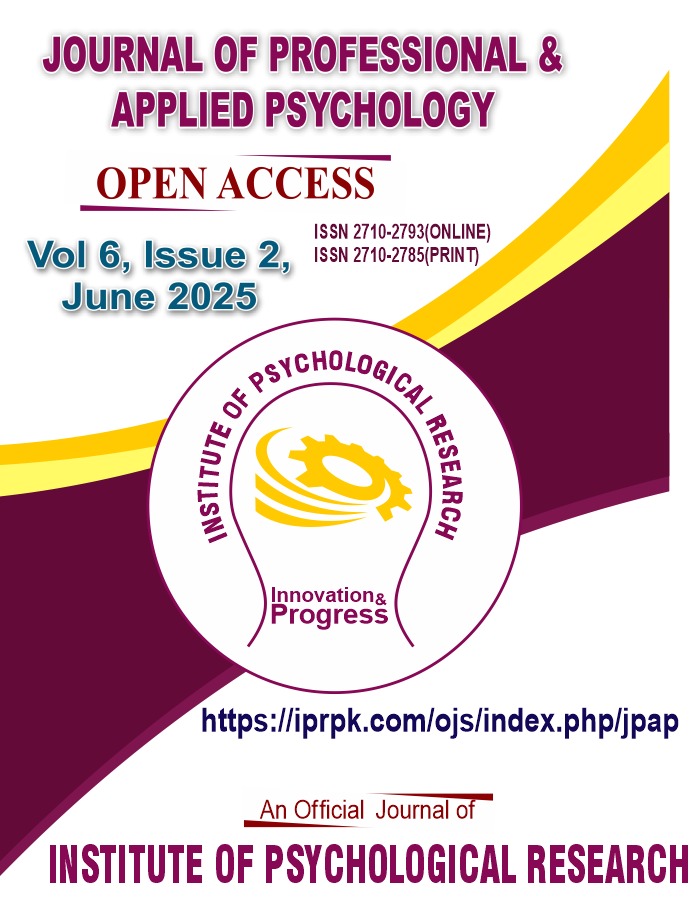The Development and Validation of an Aesthetic Treatment Psychosocial Experiences Scale: The Mind Behind the Mirror
DOI:
https://doi.org/10.52053/jpap.v6i2.375Keywords:
Adults, Aesthetic Procedures, Reliability, Treatment Experiences, ValidityAbstract
Aesthetic treatment procedures have got increased attention during current era, however, there is a significant gap in assessing the psychological aspect linked to these procedures. The current research found the manifestation and expression of treatment experiences of adults taking aesthetic procedures in Pakistan. The scale development was carried out in four phases. In phase I, in-depth interviews were conducted to elicit the key characteristics of treatment experiences from 20 adults. In the Phase II, the content validity index was established and in phase III, pilot testing was done on 20 participants to check the feasibility, layout and comprehension of the scale. In the main study, phase 300 adults (Men=45%, Women=55%) were given the Treatment experiences scale along with Depression, Anxiety, Stress Scale (DASS) to determine the psychometric properties. The principal component factor analysis using varimax rotation generated three factors of treatment experiences namely need for appraise, fear of treatment failure and result oriented thinking. Furthermore, results depict the high internal consistency, split half reliability, test-retest reliability and construct validity. The reliability of the aesthetic treatment experiences scale was (r=. 86, p< .001) and validity was (r = .25 p < .001).
References
Anoixiadou, S., Parashis, A., & Vouros, I. (2023). Minimally invasive non-surgical technique in the treatment of intrabony defects—A narrative review. Dentistry Journal, 11(1), 25. https://doi.org/10.3390/dj11010025 DOI: https://doi.org/10.3390/dj11010025
Asad, S., Hussain, S., Khalid, Z., Zaheer, W., & Sohail, W. (2024). Perceived emotional invalidation, physical appearance comparisons, and attitude towards cosmetic surgery among female undergraduate university students. Current Psychology, 43(9), 11114–11126. https://doi.org/10.1007/s12144-023-05237-1 DOI: https://doi.org/10.1007/s12144-023-05237-1
Brogan, J. L. (2020). Body image dissatisfaction and quality of life: The role of self esteem and depression in individuals seeking cosmetic surgeries (Unpublished master’s thesis). University of Edinburgh. https://doi.org/10.7488/era/938
Brown, T. (2016). Cosmetic or aesthetic? Aesthetic Surgery Journal, 36(4), NP163–NP164. https://doi.org/10.1093/asj/sjv252 DOI: https://doi.org/10.1093/asj/sjv252
Cattell, R. B. (1966). The scree test for the number of factors. Multivariate Behavioral Research, 1, 245–276. DOI: https://doi.org/10.1207/s15327906mbr0102_10
Chirico, F., Colella, G., Cortese, A., Bove, P., Fragola, R., Rugge, L., Audino, G., Sgaramella, N., & Tartaro, G. (2021). Non-surgical touch-up with hyaluronic acid fillers following facial reconstructive surgery. Applied Sciences, 11(16), 7507. https://doi.org/10.3390/app11167507 DOI: https://doi.org/10.3390/app11167507
Ejaz, A., Rehman, F. U., Nasrullah, H., Saeed, S., & Riaz, S. (2024).
Impact of social media on the adoption of cosmetic procedures among Pakistani youth. African Journal of Biological Sciences, 6(9), 5770–5778. https://doi.org/10.48047/AFJBS.6.9.2024.5770-5778
Elfving-Hwang, J. K. (2021). Man made beautiful: The social role of grooming and body work in performing middle-aged corporate masculinity in South Korea. Men and Masculinities, 24(2), 207–227. DOI: https://doi.org/10.1177/1097184X20976730
Field, A. (2013). Discovering statistics using IBM SPSS statistics (4th ed.). SAGE.
Henley, D., & Porath, N. (2021). Body modification in East Asia: History and debates. Asian Studies Review, 45(2), 198–216. https://doi.org/10.1080/10357823.2020.1849026 DOI: https://doi.org/10.1080/10357823.2020.1849026
Kaiser, H. F. (1974). An index of factorial simplicity. Psychometrika, 39, 31–36. DOI: https://doi.org/10.1007/BF02291575
Kalim, S., & Mujahid, M. (2024). Eurocentric beauty standards: A corpus-assisted discourse analysis of Pakistani skincare blogs. Academia.edu.
Kashmar, M., Alsufyani, M. A., Ghalamkarpour, F., Chalouhi, M., Alomer, G., Ghannam, S., El Minawi, H., Saedi, B., Hunter, N., & Alkobaisi, A. (2019). Consensus opinions on facial beauty and implications for aesthetic treatment in Middle Eastern women. Plastic and Reconstructive Surgery Global Open, 7(4). e2220. https://doi.org/10.1097/GOX.0000000000002220 DOI: https://doi.org/10.1097/GOX.0000000000002220
Khan, S., Shahid, S., & Nawaz, Z. (2023).
Social media and its impact on beauty standards among Pakistani women. Journal of South Asian Studies, 38(1), 112–130. https://doi.org/10.70135/seejph.vi.5978
Khan Tribune. (2023, October 12). Glow up Pakistan: From fairness to self-care. The Express Tribune. https://tribune.com.pk
Kline, P. (1994). An easy guide to factor analysis. Routledge.
Li, K., Meng, F., Li, Y. R., Tian, Y., Chen, H., Jia, Q., Cai, H., & Jiang, H. B. (2022). Application of nonsurgical modalities in improving facial aging. International Journal of Dentistry, 2022. https://doi.org/10.1155/2022/8332631 DOI: https://doi.org/10.1155/2022/8332631
Lovibond, S. H., & Lovibond, P. F. (1995). Manual for the Depression Anxiety Stress Scales (2nd ed.). Psychology Foundation. DOI: https://doi.org/10.1037/t01004-000
Lynn, M. R. (1986). Determination and quantification of content validity. Nursing Research, 35(6), 382–386. https://doi.org/10.1097/00006199-198611000-00017 DOI: https://doi.org/10.1097/00006199-198611000-00017
Madan, S., Basu, S., Ng, S., & Ching Lim, E. A. (2018). Impact of culture on the pursuit of beauty: Evidence from five countries. Journal of International Marketing, 26(4), 54–68. https://doi.org/10.1177/1069031X18805493 DOI: https://doi.org/10.1177/1069031X18805493
Maisel-Campbell, A., Waldman, A., Dave, L., Poon, E., & Alam, M. (2024). Why different types of patients seek cosmetic treatments. Archives of Dermatological Research, 316, 84. https://doi.org/10.1007/s00403-023-02813-0 DOI: https://doi.org/10.1007/s00403-023-02813-0
McKeown, D. J. (2021). Impact of minimally invasive aesthetic procedures on the psychological and social dimensions of health. Plastic and Reconstructive Surgery Global Open, 9(4), e3578. https://doi.org/10.1097/GOX.0000000000003578 DOI: https://doi.org/10.1097/GOX.0000000000003578
Miyake, A., & Friedman, N. P. (2012). The nature and organization of individual differences in executive functions: Four general conclusions. Current Directions in Psychological Science, 21, 8–14. https://doi.org/10.1177/0963721411429458 DOI: https://doi.org/10.1177/0963721411429458
Mori, F., Melita, D., Innocenti, M., & Ciancio, F. (2024). Reduction of the areolar diameter after ultrasound-assisted liposuction for gynecomastia. Academia.edu.
Paleebutt, W., & Thaipwaree, T. (2022). The mythology of beauty and social media influences [Unpublished master’s thesis, Silpakorn University]. Silpakorn University Institutional Repository. https://sure.su.ac.th/handle/123456789/715
Payer, J., Chalkidis, N., Polackova, P., & Patzelt, M. (2024). MAMAS: A standardized template of pre-operative marking and step-by-step surgical procedure. JPRAS Open, 40, 293–304. https://doi.org/10.1016/j.jpra.2024.03.007 DOI: https://doi.org/10.1016/j.jpra.2024.03.007
Praveena, J., Gokulakrishnan, Narasimman, P., & Sankar, G. (2025). Pilot study on the role of facial acupuncture in achieving skin hydration and oil equilibrium. Indian Journal of Integrative Medicine, 5(2), 1-6. https://mansapublishers.com/index.php/ijim/article/view/4949/4196
Rahman, E., Carruthers, J. D. A., Rao, P., Abu-Farsakh, H. N., Garcia, P. E., Ioannidis, S., Sayed, K., Philipp-Dormston, W. G., Mosahebi, A., & Webb, W. R. (2025). Regenerative Aesthetics: A Genuine Frontier or Just a Facet of Regenerative Medicine: A Systematic Review. Aesthetic Plastic Surgery, 49(1), 341–355. https://doi.org/10.1007/s00266-024-04287-5 DOI: https://doi.org/10.1007/s00266-024-04287-5
Reddinger, S., Felimban, M., Shaikh, A. H., Jamal, A., Timraz, J. H., Khan, A. A., Rashid, W., Sultan, S. R. M., Khan, S., Hashim, S. N., Thalib, H. I., Albeez, S. F., Makki, F., & Khan, A. (2024). The impact of social media on beauty standards: A systematic review and meta-analysis of patient and cosmetic provider perspectives. South Eastern European Journal of Public Health, 26(S2), 4045–4067. https://doi.org/10.70135/seejph.vi.5978 DOI: https://doi.org/10.70135/seejph.vi.5978
Shi, J. (2024). Psychosocial determinants and outcomes of female facial plastic surgery: A data-driven analysis [Working paper]. SSRN. https://doi.org/10.2139/ssrn.4906606 DOI: https://doi.org/10.2139/ssrn.4906606
Skin Fudge. (2023, October 13). Cultural significance of aesthetic enhancements in Pakistan. SKINFUDGE Lahore | Dermatologist, Allergy & Aesthetic Center. https://www.skinfudge.com
Smith, J., Doe, A., & Roe, M. (2021). Social media and self-objectification: A new look at body image issues. Journal of Digital Mental Health, 3(2), 45–59. https://doi.org/10.1000/jdmh.2021.0023
Tabachnik, B. G., & Fidell, L. S. (2013). Using multivariate statistics. Harper Collins.
Ventura, N., & Arthur, E. (2023, July 24). Psychological effects of cosmetic procedures extend far beneath the surface. Dermatology Times, 44(7). https://www.dermatologytimes.com
Warnick, S. (2024). Complexities of companionship: Exploring the human–dog relationship through mtDNA analysis of Bridge River canine remains (Master’s thesis, University of Montana). ScholarWorks at University of Montana. https://scholarworks.umt.edu/etd/12365
Downloads
Published
How to Cite
Issue
Section
Categories
License
Copyright (c) 2025 Samra Sabeel, Ayesha Jabeen, Sadia Saleem

This work is licensed under a Creative Commons Attribution-NonCommercial 4.0 International License.
Creative Commons Attribution-Non Commercial 4.0 International (CC BY-NC 4.0) License: This article is distributed under the terms of the Creative Commons Attribution-Non Commercial 4.0 International License (https://www.creativecommons.org/licenses/by-nc/4.0/) which permits non-Commercial use, reproduction and distribution of the work without further permission provided the original work is attributed as specified on the Journal website at (https://iprpk.com/ojs/index.php/jpap)












